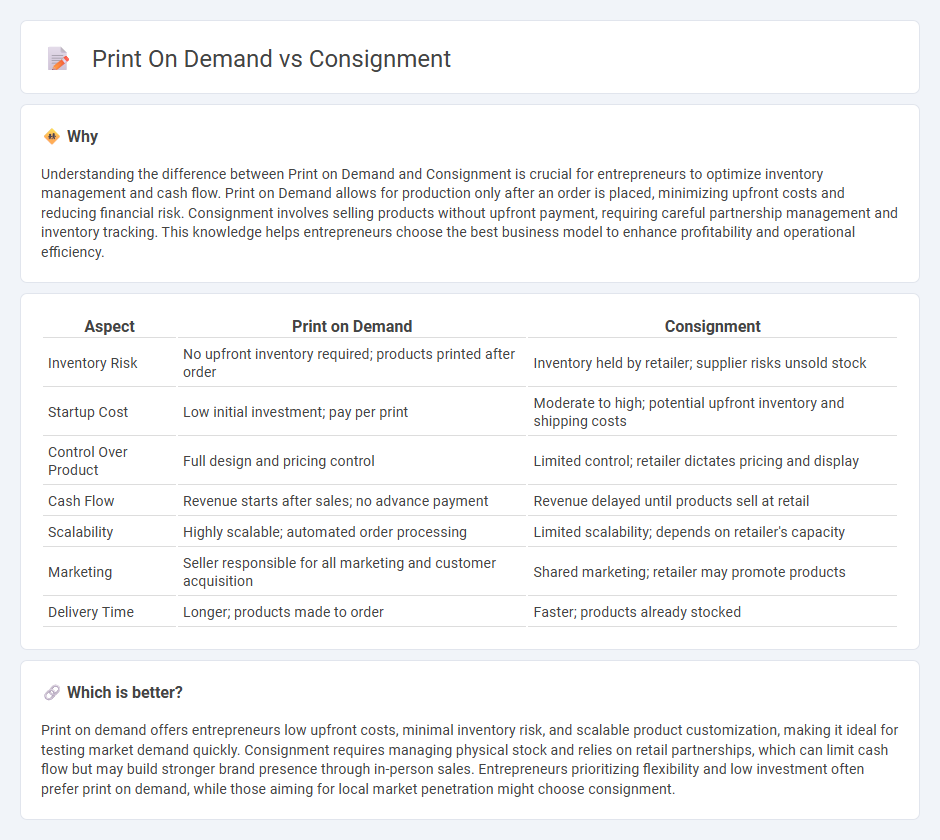
Print on demand enables entrepreneurs to launch customized products with minimal upfront investment, leveraging digital printing technology to fulfill orders individually and reduce inventory risk. Consignment involves partnering with retailers to sell products, where suppliers retain ownership until the item is sold, which can help entrepreneurs test markets without heavy capital but often limits pricing control. Explore these business models further to determine which strategy aligns best with your entrepreneurial goals.
Why it is important
Understanding the difference between Print on Demand and Consignment is crucial for entrepreneurs to optimize inventory management and cash flow. Print on Demand allows for production only after an order is placed, minimizing upfront costs and reducing financial risk. Consignment involves selling products without upfront payment, requiring careful partnership management and inventory tracking. This knowledge helps entrepreneurs choose the best business model to enhance profitability and operational efficiency.
Comparison Table
| Aspect | Print on Demand | Consignment |
|---|---|---|
| Inventory Risk | No upfront inventory required; products printed after order | Inventory held by retailer; supplier risks unsold stock |
| Startup Cost | Low initial investment; pay per print | Moderate to high; potential upfront inventory and shipping costs |
| Control Over Product | Full design and pricing control | Limited control; retailer dictates pricing and display |
| Cash Flow | Revenue starts after sales; no advance payment | Revenue delayed until products sell at retail |
| Scalability | Highly scalable; automated order processing | Limited scalability; depends on retailer's capacity |
| Marketing | Seller responsible for all marketing and customer acquisition | Shared marketing; retailer may promote products |
| Delivery Time | Longer; products made to order | Faster; products already stocked |
Which is better?
Print on demand offers entrepreneurs low upfront costs, minimal inventory risk, and scalable product customization, making it ideal for testing market demand quickly. Consignment requires managing physical stock and relies on retail partnerships, which can limit cash flow but may build stronger brand presence through in-person sales. Entrepreneurs prioritizing flexibility and low investment often prefer print on demand, while those aiming for local market penetration might choose consignment.
Connection
Print on demand and consignment intersect in entrepreneurial ventures by enabling low-risk inventory management and flexible product offerings. Print on demand minimizes upfront costs through on-demand production, while consignment reduces financial burden by selling products through retailers who pay only after sale. This synergy allows entrepreneurs to scale businesses efficiently by leveraging outsourced fulfillment and distribution channels.
Key Terms
Inventory Ownership
Consignment inventory remains the property of the supplier until sold, minimizing upfront costs for retailers but increasing inventory risk for suppliers. Print on demand eliminates inventory ownership entirely by producing items only after a customer places an order, reducing storage costs and obsolescence. Discover the best inventory strategy tailored for your business needs and maximize operational efficiency.
Fulfillment Process
Consignment fulfillment involves the retailer holding inventory supplied by the manufacturer, managing stock levels and sales, while payment is made only after an item sells, reducing upfront costs but increasing inventory responsibility. Print on demand fulfillment eliminates inventory by producing items only after an order is placed, streamlining operations and minimizing risk with direct shipping from the printer to the customer. Explore more about these fulfillment models to choose the best option for your business needs.
Payment Timing
Consignment models typically delay payment until items are sold, meaning sellers receive revenue after the customer purchases the product, which can affect cash flow. Print on demand processes payment upfront or at the time of order, enabling faster revenue recognition and reducing inventory risk for sellers. Explore detailed comparisons to determine the best payment structure for your business needs.
Source and External Links
consignment | Wex | US Law | LII / Legal Information Institute - Consignment is a contract where the consignor delivers goods to the consignee for sale, with the consignor retaining ownership until the goods are sold and the consignee paying the sale proceeds after sale.
what is consignment, how it works, and examples - Consignment is a business arrangement in which one party sells goods on behalf of another for a fee or commission, commonly used for unique or second-hand products like clothing, antiques, and art.
Consignment - Consignment involves giving another party permission to care for property while retaining ownership, with accounting rules specifying when revenue is recognized, generally after sale or return of goods.
 dowidth.com
dowidth.com